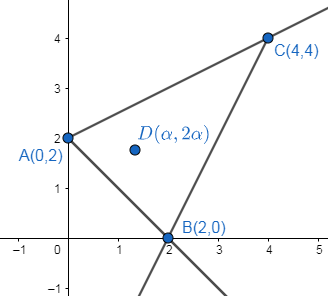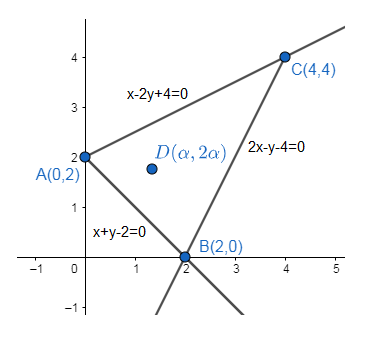Question
Question: The values of \[\alpha \] if \[(\alpha ,2\alpha )\]lies inside the \[\Delta ABC\] if \[A(0,2),B(2,...
The values of α if (α,2α)lies inside the ΔABC if
A(0,2),B(2,0)and C(4,4)
(a) α∈(31,32)
(b) α∈(32,1)
(c) α∈(32,34)
(d) α∈(31,1)
Solution
Hint: Find the equation of the lines which are forming the triangle.
The figure for the given problem is as follows:

Now we will find the equations of all the three sides of the triangle.
We know equation of line between the two points (x1,y1) and (x2,y2)can be written as,
y2−y1y−y1=x2−x1x−x1
Applying the above formula, the equation of side AB is,
0−2y−2=2−0x−0
−2y−2=2x
−1y−2=1x
On cross multiplication, we get
y−2=−x
x+y−2=0........(i)
Similarly, the equation of side BC is,
4−0y−0=4−2x−2
4y=2x−2
2y=1x−2
On cross multiplication, we get
y=2x−4
2x−y−4=0........(ii)
And, the equation of side AC is,
4−2y−2=4−0x−0
2y−2=4x
1y−2=2x
On cross multiplication, we get
2y−4=x
x−2y+4=0........(iii)
Therefore the figure with equations is,

Two given points (x1, y1)and (x2, y2)will lie on the same side of the line ax+by+c=0 if ax1+by1+c and ax2+by2+c will have same signs.
From the above figure it is clear that the points B and D lie on the same side of the line AC. So, it should satisfy the above condition, i.e.,
2−2(0)+4=6>0
So, when we substitute the value of point D in line AC, it should be greater than zero, i.e.,
α−2(2α)+4>0
α−4α+4>0
−3α+4>0
4>3α
⇒α<34.........(iv)
Now from the above figure it is clear that the points C and D lie on the same side of the line AB. Substitute value of point C in equation of line AB, we get
4+4−2=6>0
So, when we substitute the value of point D in line AB, it should be greater than zero, i.e.,
α+2α−2>0
3α−2>0
3α>2
⇒α>32.........(v)
So, from equation (iv) and (v), we get
α∈(32,34)
Hence the correct answer is option (c).
Note: We can solve this by finding boundaries of x and y. But the options are given in fraction form, using this method it gives the exact answer.
